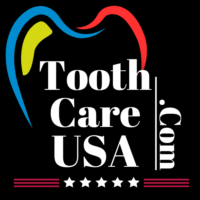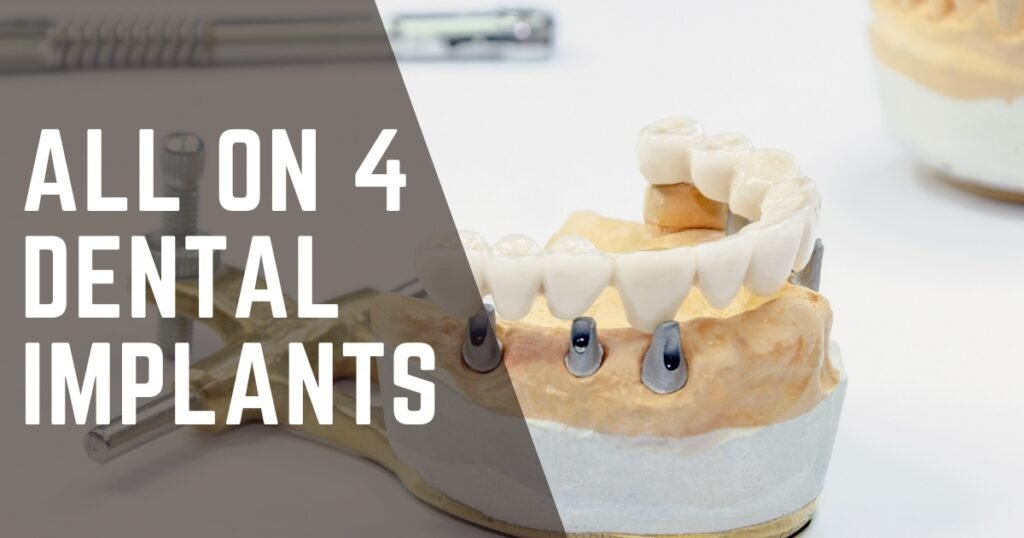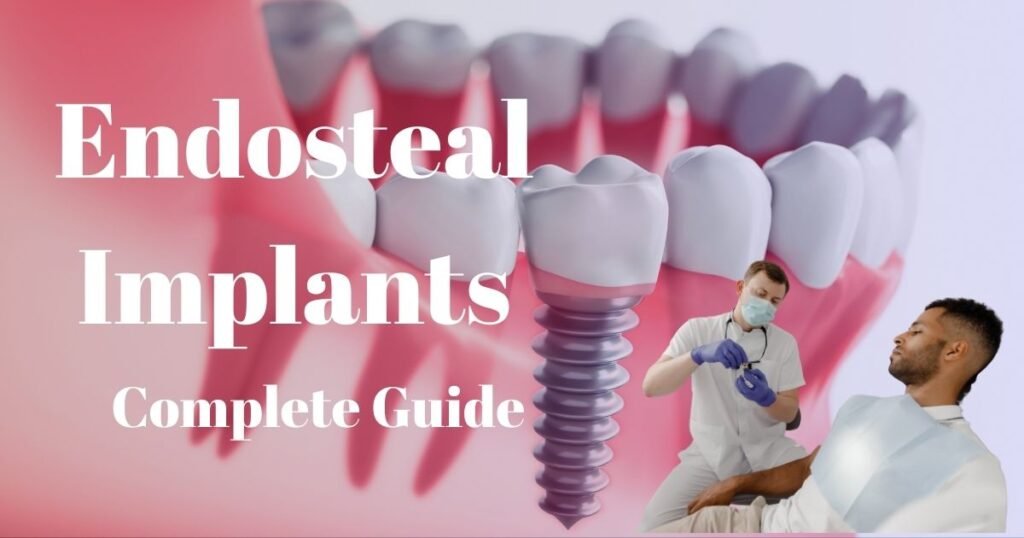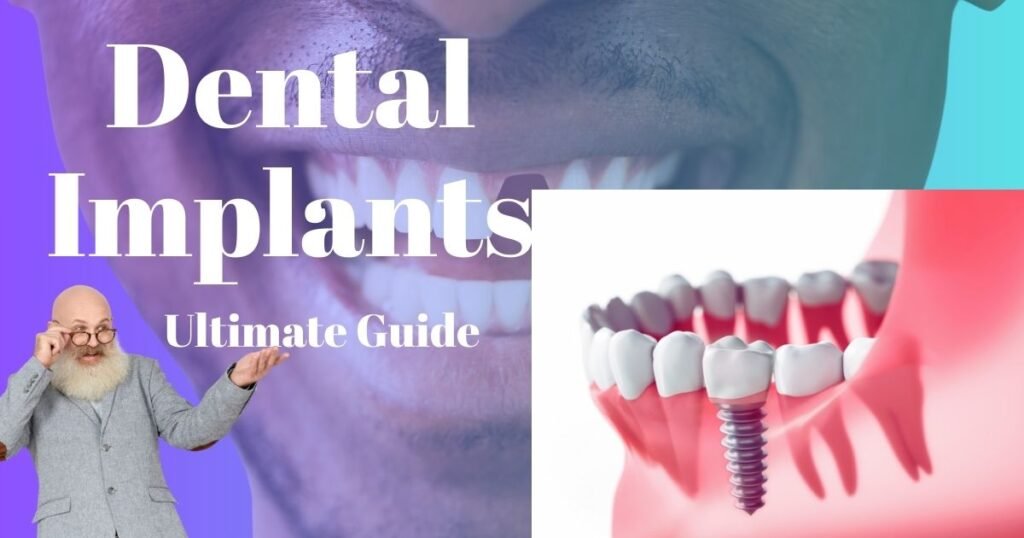All on 4 dental implants have transformed the science of oral rehabilitation, providing a permanent and effective replacement for patients struggling with the loss of multiple or all of their teeth. With All on 4 dental implants, an entire arch of restorations is supported by only four implants to improve stability, function, and appearance. All on 4 dental implants are unlike conventional dentures and are a breakthrough in dental science for people wanting a permanent solution.
Our all on 4 dental implants guide will detail everything you need to know about all on 4s, from the advantages, to the cost, to the procedure itself, to differences compared to other methods, to aftercare. All on 4 dental implants are becoming so popular because they outperform anything else, and they can change your life.
What Are All on 4 Dental Implants?

All-on-4 Dental Implants: Interactive Tool
All-on-4 is a dental implant technique that replaces a full arch of teeth using only four implants. It’s designed for patients who’ve lost most or all of their teeth and want a permanent, fixed solution without traditional dentures.
The typical cost for All-on-4 dental implants in the U.S. ranges from $15,000 to $30,000 per arch, depending on the materials, provider, and region.
- All-on-4: Fixed, permanent, more natural-looking, higher upfront cost.
- Dentures: Removable, less expensive, may slip/move, requires adhesive.
Q: How long do All-on-4 implants last?
A: With proper care, they can last 20+ years or more.
Q: Is the procedure painful?
A: Most patients report minimal pain and a quick recovery, especially with sedation.
Q: How soon can I get teeth after surgery?
A: Often, temporary teeth are placed the same day!
ALL ON 4 The All-on-4 treatment concept is a cost-efficient, graftless solution that provides patients with a fixed full-arch prosthesis on the day of surgery. Implants are placed at special angles at the location of the most bone to support prosthetic teeth properly. The All on 4 is a much better option to regular dentures; as on 4 dental implants are incredibly more stable than traditional dentures.
Key Features of All on 4 Dental Implants:
- Number of implants: 4 in each arch
- Placement Angle: Two implants were placed straight in the front, and two angled at the back
- Composition: Titanium criteria together with acrylic or porcelain microcriteria, or criteria in zirconia
- Healing Time: Immediate function in many cases, final prosthesis following 3-6 monthsmonths
- Lifespan: Over 20 years with appropriate care
Comparison Table: All on 4 Dental Implants vs. Other Restorative Options
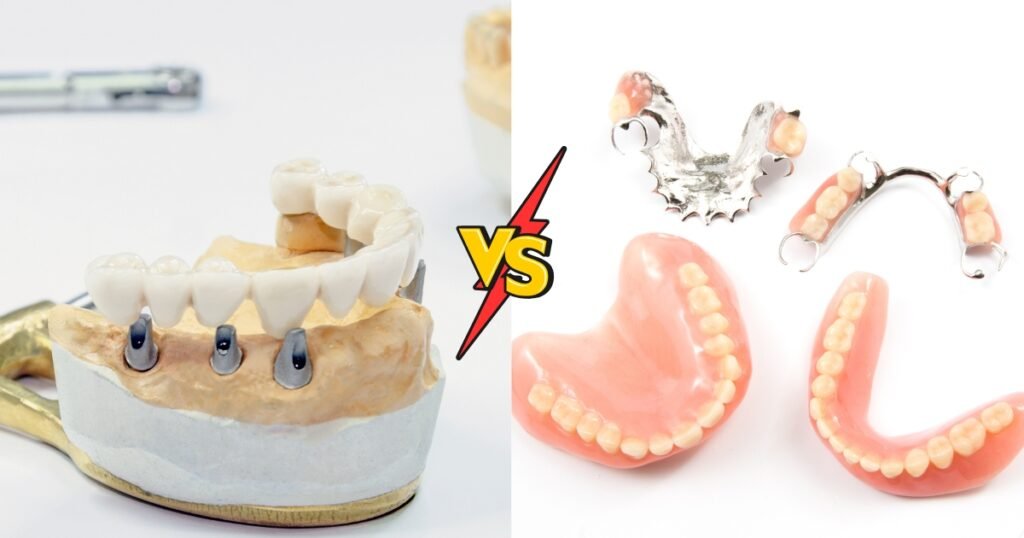
| Feature | All on 4 Dental Implants | Traditional Dentures | Individual Implants |
|---|---|---|---|
| Stability | High | Low | Very High |
| Bone Preservation | Prevents Bone Loss | Bone Resorption Occurs | Prevents Bone Loss |
| Aesthetics | Natural-Looking | Can Look Artificial | Natural-Looking |
| Comfort | Fixed & Comfortable | Can Be Loose | Fixed & Comfortable |
| Cost | Moderate to High | Low | High (per tooth) |
| Maintenance | Similar to Natural Teeth | Requires Regular Adjustments | Similar to Natural Teeth |
The Procedure: Step-by-Step Guide to All on 4 Dental Implants

Step 1: Initial Consultation
The patient’s oral health will be assessed by the dentist with:
- Routine 3D CBCT scan of bone quality and structure
- Prosthetic Design with Digital Impressions
- Review of Medical History for appropriateness.
Step 2: Treatment Planning
A personalized solution is developed through:
- Number of missing teeth
- Bone structure and density
- Desired prosthetic material
Step 3: Implant Placement Surgery
- Local or IV sedation is given.
- The remaining teeth are pulled, if necessary, by the dentist.
- Four Ti implants are screwed in place.
- Bond the temporary teeth to the posts.
Step 4: Healing and Osseointegration (3-6 Months)
- All on 4 dental implants fuse with the bone.
- A soft diet is recommended for the patients.
- Regularly so that the healing is a success.
Step 5: Permanent Prosthetic Placement
- After the implants heal to the bone, a definitive prosthesis (zirconia or porcelain) is placed.
- Adjustments ensure a perfect fit.
Advantages of All on 4 Implants
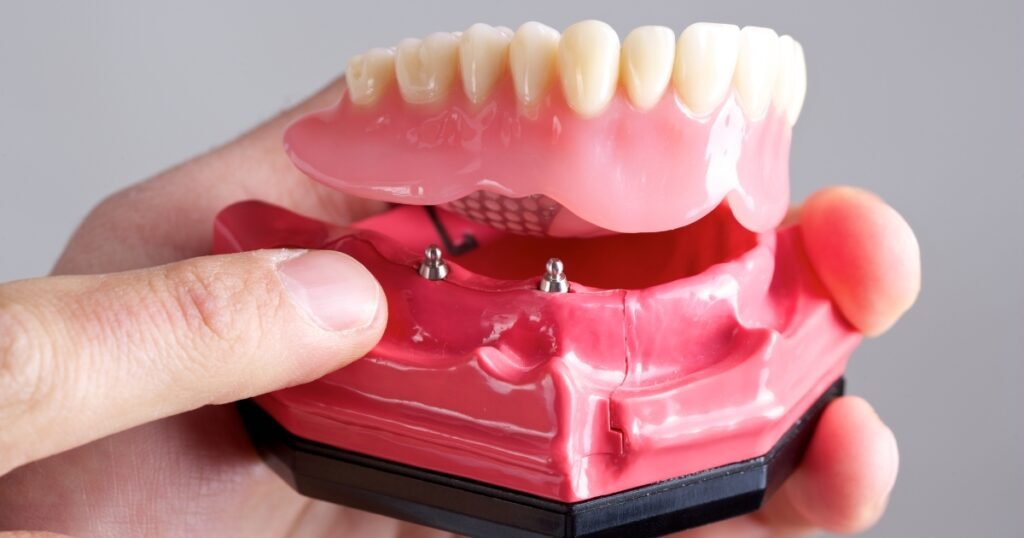
1. Immediate Functionality
- Temporary teeth are attached on the same day of surgery.
- Patients may eat soft food as soon as desired.
2. Bone Preservation
- Prevents bone loss in the jaw due to missing teeth.
- Promotes natural growth of the bone.
3. Increased Comfort and Stability
- Fixed prosthetics eliminate the discomfort of removable dentures.
- No slipping or shifting while eating or speaking.
4. Cost-Effective
- Only needs four implants as opposed to one per tooth.
- Long-term investment as compared to conventional dentures.
5. Natural Appearance
- Prosthetic implants are created to match your other teeth in color, form, and size.
- Win back your self-esteem with a great smile.
6. Long-Lasting Solution
- Implants are maintained for over 20 years.
- Materials such as zirconium are wear- and stain-resistant, too.
Who is an Ideal Candidate for All on 4 Dental Implants?
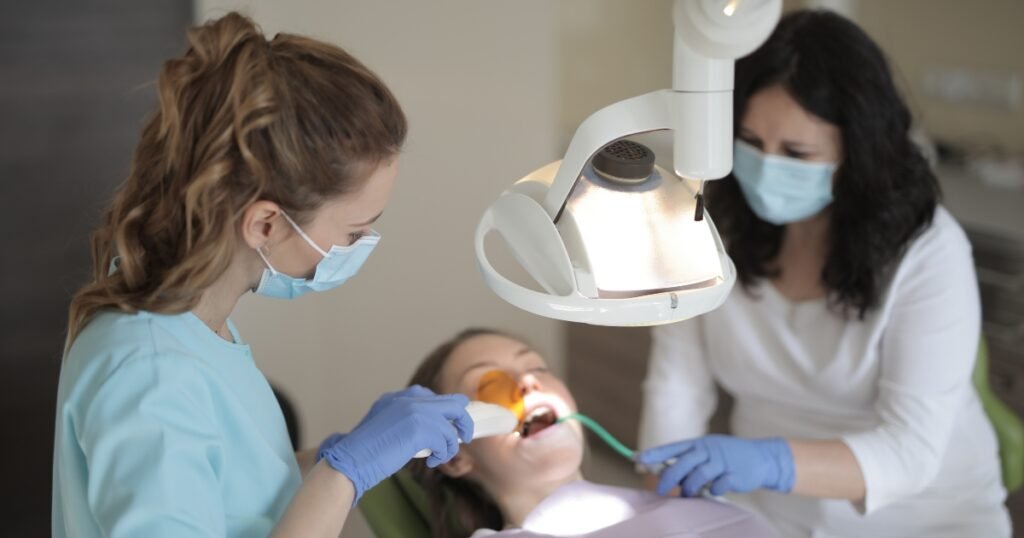
The Best Candidates For All on 4 Dental Implants. Most patients who receive All on 4 dental implants:
- Have multiple missing or failing teeth.
- Have advanced periodontal disease or tooth decay.
- They are unhappy with conventional dentures.
- Have enough jawbone, or can have a bone graft.
Contraindications for All on 4 Dental Implants:
- Uncontrolled diabetes can also delay the healing process.
- Advanced osteoporosis (bones will be weaker)
- Heavy Smoking (Interferes with osseointegration)
- Bad oral hygiene (risk of implant failure)
What is the breakdown of costs for All on 4 Dental Implants
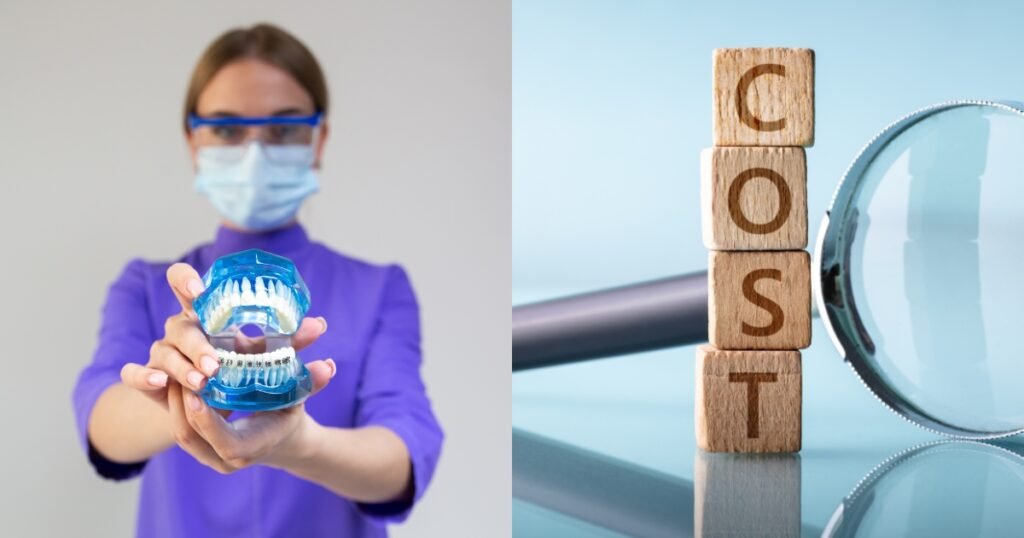
The price can change based on location, the dentist’s experience, and the type of material used. See a rough estimate of how much you can expect to pay in cost below:
| Cost Component | Price Range (USD) |
|---|---|
| Initial Consultation | $100 – $300 |
| 3D Imaging & X-rays | $200 – $500 |
| Surgery & Implants | $10,000 – $25,000 per arch |
| Temporary Prosthesis | Included in total cost |
| Final Prosthetic Teeth | $5,000 – $15,000 per arch |
| Total Cost (Per Arch) | $15,000 – $40,000 |
After Care and Maintenance of All on 4 Implants
Immediate Aftercare (First Week)
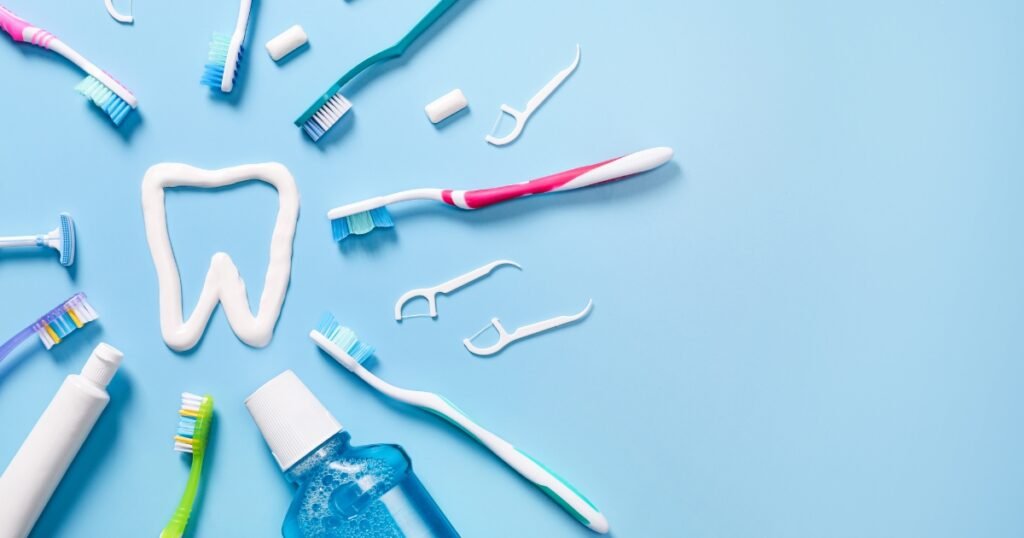
- Go with soft foods (mashed potatoes, yogurt, scrambled eggs).
- Do not consume hot liquids for the next 24 hours.
- Take antibiotics and pain-relieving medications as prescribed.
- Do not rinse your mouth too vigorously during the first 24 hours.
Long-Term Care
- Oral Hygiene:
- Use soft-bristled toothbrushes to brush twice a day.
- Use non-abrasive toothpaste.
- Rinse using a mouthwash that contains no alcohol.
- Regular Dental Visits:
- Cleaning and evaluation are done twice a year.
- Periodic professional deep cleaning every 6-12 months.
- Dietary Considerations:
- Avoid overdoing firm, sticky, or acidic foods.
- You should try to restrict your consumption of sugary foods and drinks that can cause gum inflammation.
- Lifestyle Changes:
- Give up smoking to make the implants last.
- Have a healthy diet for the benefit of your oral health.
Conclusion
All on 4 Dental Implants provide a permanent, natural, and economical solution to full-arch tooth replacement. Because of the success rate that comes with All on 4 dental implants, along with the many advantages that come with them, we recommend this service for those of you looking to bring a smile back to your face.
With the right post-treatment care and routine dental visits, you can enjoy long-term success, with All on 4 dental implants truly a transformative investment in oral health and self-confidence.
What is the downside of All-on-4 dental implants?
The primary disadvantages of All-on-4 dental implants are relatively high initial costs, possible discomfort during rehabilitation, and the possibility of implant failure. They also may not work for people who have lost too much bone or who have some medical conditions.
Major Disadvantages of All on 4 Dental Implants
Expensive – If you get this treatment done, then it will cost you more than your standard dentures or single implants.
Pain Relief – swelling and pain, and perception problems may occur after the surgery.
Risk of Implant Failure – Poor density of bone or poor aftercare might result in failure.
Not for Everyone — If you have advanced bone loss or if you have diabetes that is not under control, you may not be a candidate.
22 Fixed Prosthetic – Any changes or repair of a fixed restoration may be more complicated.
Potential Speech Changes – Some modifications in speech may be present at first.
Food getting stuck – Needs meticulous oral hygiene to avoid infections.
The All-on-4 Implants provide strength and function. The All-on-4 implants are both durable and convenient, but all these must be considered before deciding on the treatment.Can I eat normally with All-on-4 dental implants?
Yes, All on 4 Dental Implants will allow you to eat as you normally would after you have healed. They offer a robust serviceable foundation for chewing foodstuffs, such as natural teeth.
Eating with All on 4 Dental Implants
Only eat soft foods during the first weeks – Contributes to healing and prevents tension.
Slowly Begin Adding More Firm Foods – You can eat normally when you are completely healed.
Avoid very hard or sticky foods – Can cause damage to the prosthesis.
Balance biting force on both sides — Prevent tooth collapse and save implants.
Good oral health can minimize the chances of infections and the implant not being successful.Are All on 4 Dental Implants worth the money?
Yes, All-on-4 implants are worth the investment for those seeking a long-term, natural-looking tooth replacement. They offer durability, stability, and improved quality of life compared to dentures.
Reasons All-on-4 Implants Are Worth It
Permanent solution – Lasts decades with proper care.
Stronger bite force – Allows eating a wider range of foods.
Prevents bone loss – Maintains jaw structure and facial appearance.
More comfortable than dentures – Fixed in place, no slipping or irritation.
Improves confidence – Looks and feels like natural teeth.Do All on 4 Dental Implants feel like real teeth?
Yes, All on 4 Dental Implants are as close to natural teeth as you can get. They are implanted in the jawbone, which adds stability and maintains a natural bite.
Why All-on-4 Feels Natural
Excellent retention – no more movement like conventional dentures.
Prosthetics are fabricated to an ideal tooth form and size.
Restores natural biting force – Enabling you to enjoy your favorite foods and maintain a healthy diet.
5. No unwieldy palate cover- They don’t alter taste or speech like dentures.
Little gum irritation: No rubbing or soreness like removable dentures.Who is not a candidate for All-on-4 dental implants?
Individuals with advanced bone loss, uncontrolled diabetes, or certain health complications may not be good candidates for All-on-4 implants. You would need a dental examination.
Who Should Avoid All on 4 Dental Implants?
Extensive bone loss without grafting – There may not be enough jaw bone to support the teeth implants.
Untreated diabetes – The Healing process is slowed, and infection risk is greater.
Heavy smokers- Nicotine narrows the blood vessels that impact implant survival.
Autoimmune issues – diseases such as lupus or rheumatoid arthritis can interfere with healing.
Bad habits of oral hygiene – Risks the possibility that the implant doesn’t grip correctly.How painful are All-on-4 dental implants?
The protocol is somewhat painful, so I requested some pain medication before each one. Swelling and discomfort are normal for several days following surgery in most patients.
Pain and Recovery Timeline
Day 1-3: Swelling with aching and discomfort controlled by using pain medication.
Week 1: Discomfort decreases, and soft foods are recommended.
Weeks 2-4: You are healing, and some sensitivity can be expected.
3 -6 months: No obvious symptoms, implants are fully healed in the jawbone.Are All-on-4 implants covered by insurance?
Coverage is subject to the insurance policy and plan design. Certain plans are partially covering it, while others are calling it cosmetic and have no coverage.
Factors Affecting Coverage
Medical necessity – Some plans cover implants if patients cannot wear dentures.
Type of insurance – dental v/s medical. Dental insurance may have different polices.
Pre-authorization- Authorization needed. Pre-authorization is necessary- Check for this because some insurance companies require proof of necessity prior to approval.
Out-of-pocket expenses – Financing or installment plans are used by many patients.
Other coverage options — Discount plans or dental savings accounts may come in handy.Is it hard to talk with All-on-4 dental implants?
There may be a brief period of recalibration, but most people readjust to normal speech within a day or so. All-on-4 implants don’t move or shift when speaking, as dentures do.
The Influence of Speech Compensation on All on 4 Dental Implants
Lisp or slurred speech at the start - This often goes away after the mouth gets used to having an expander fitted.
Go slow when you speak –Contributes to clarity for the first few weeks.
Read aloud – Accelerates the adaptation to the new prosthesis.
No palate implant wear does not cover your palate like a denture.
Complete speech restoration – Within a couple of weeks, typicallyWho should not have dental implants?
Some health conditions and habits can make dental implants inappropriate. An assessment by a dentist will determine eligibility.
When to Avoid Dental Implants?
Advanced gum disease may cause insufficient bone support for implants.
Uncontrolled diabetes – increased susceptibility to infection and delayed wound recovery.
Smoking, tobacco – It may not be successful due to poor blood circulation.
Autoimmune diseases can cause the body to reject the implants.
Not enough bone density – Need for bone grafting before implantationWhat is the failure rate of All on 4 Dental Implants?
Success rates in all-on-4 implants are over 95%; however can fail from infection, poor bone, and also from not caring for them properly.
Reasons for Implant Failure
Low level of integration with the bone – A loose jawbone implant could have a lack of osseointegration.
Infections (peri-implantitis) – Accumulation of bacteria can cause the implant to fail.
Smoking, or negative lifestyle behaviors, harm the healing process and long-term stability.
Medical problems – Some medical conditions, such as osteoporosis, can influence bone support.
Poor oral hygiene- It can elevate the chances of implant failure.Does food get stuck under All on 4 Dental Implants?
Yes, bits of food can collect under All on 4 Dental Implants, but a cleaning regimen applied daily can help prevent their accumulation and any subsequent infections.
How to avoid the food from getting stuck
Water flosser – Rinses food debris out of pita pockets.
Interdental brushes – For those hard-to-reach spaces.
Daily use of implant-specific floss under the bridge. If needed, you will require an implant-specific floss to clean under the bridge.
Wash with anti-microbial mouthwash- it helps to prevent bacteria from accumulating.
Routine dental exams – Allow your implants to be kept clean and disease-free.How long does it take for All on 4 Dental Implants to heal?
The primary healing is complete after 1-2 weeks, but complete osseointegration (bone fusion) takes 3-6 months.
Healing Timeline
Days 1-3– swelling and minimal discomfort; patient should be on a soft diet.
Week 1-2: Swelling goes down to the most that it will, and softer foods are introduced.
Bone begins to integrate with the implants around 1-3 months.
3 to 6 months – Total fusion taking place, able to eat normally and at full capacity.
Phase III: At 6 months – Definitive prosthetic adjustments, if necessary.How do you clean under All-on-4 dental implants?
Cleaning under All-on-4 implants. There are special ways and tools for you to clean around All on 4 Dental Implants to avoid food and bacteria buildup.
Cleaning Steps
Water flosser – Assists in washing out trapped food and bacteria.
Inter-dental brushes – Cleans between the implants/aesthetic crown and under the bridge.
Daily Flossing – Make use of implant-specific floss or super floss to reach into implants if it’s needed.
Gargle with a mouthwash – An antimicrobial mouthwash can prevent infections.
Pulse 2 times each day using a soft-bristle brush — Helps protect your implants from any kind of damage.
Get regular dental cleanings – Professional cleanings are essential to the health of dental implants.How long do All on 4 Dental Implants last?
With good care, All on 4 Dental Implants can last 20 years or longer, and in some case,s a lifetime.
Factors Affecting Longevity
Oral care routine -Regular cleaning keeps infections away.
Diet and lifestyle – Avoidance of hard food and smoking enhances longevity.
Jaw support prevents resorption of healthy jaw bone for long-term stability.
Implant material quality – Higher quality materials have better lifespan. Profile of implant – Not all implants are the same.
Routine dental preventatives – As they say, “an ounce of prevention is worth a pound of cure.How painful are All on 4 Dental Implants?
The treatment is not that comfortable, but it’s manageable with painkillers. The majority of patients are swollen and sore for a few days following surgery.
Pain and Recovery Timeline
DAY 1-3: Inflammation, tenderness , and Minimal discomfort were being controlled with pain meds.
Week One: Discomfort decreases, but soft foods are still encouraged.
Weeks 2-4: Wound healing continues, with little or no sensitivity.
3-6 months: Complete healing is achieved, and implants are completely bonded into the jawbone.What is the failure rate of All on 4 Dental Implants?
95% of the time, All-on-4s are successful, but they can still fail due to infections, bad bones, and not taking care of them.
Reasons for Implant Failure
Deficient bone integration – Absence of osseointegration can result in instability.
Infection (peri-implantitis) – Risk of bacteria accumulating and failure.
Smoking or Bad habits impair healing and long-term tenacity.
Health disorders – Conditions such as osteoporosis can affect the support of the bone.
Oral hygiene – Poor oral hygiene can increase the risk of complications from an implant.Do they put you to sleep for All on 4 Dental Implants?
Yes – most patients are given IV sedation, or are put under general anesthesia to enable them to enjoy a pain-free surgery. You can also choose to have a local anesthesia, but it leaves you awake while causing the surgical area to go numb.
Types of Sedation Used
Local anaesthesia – No feeling in the surgical region, but you are still awake.
IV Sedation – Brings the person to a relaxed and semi-awake state.
General anesthesia — You are completely asleep, done in more complex cases.
Sedation: Oral – offers light sedation for nervous patients.Which is better: All-on-4 or All-on-6 dental implants?
The All-on-6 is a more rigid system and longer-lasting than a full arch, but the All-on-4 is less expensive and requires less bone density. Depending on your budget and overall oral health, your decision may vary.
Key Differences
Support – Unlike All-on-4, All-on-6 provides better pressure distribution.
Bone need – All on 4 Dental Implants is compatible with reduced bone.
Price – All on 4 Dental Implants tends to be cheaper.
Lifespan – All-on-6 may survive longer because of the extra implants.
Length of procedure – They’re both fast procedures, but the all-on-four may take less time.Can All on 4 Dental Implants fall out?
Yes, but it’s rare. Healing can be inadequate, or if the force on the implant is too much and failure can happen. With proper care and frequent dentist visits, this can be avoided.
Normal reasons for the failure of an implant
Bad osseointegration – Bone doesn’t graft well enough.
Infection (peri-implantitis) – Bacteria undermine the implants’ strength.
Too much biting force, either from grinding your teeth in your sleep or from chewing hard foods.
Loss of bone (atrophy): There may be inadequate jawbone support.
Bad dental hygiene causes gum disease and failing implants.Why are All on 4 Dental Implants so expensive?
The price really does reflect the tech, the kit, and the skill needed. It also incorporates surgical treatment, laboratory, and subsequent follow-up care.
Factors Affecting Cost:
expensive implant materials — Titanium and zirconia are expensive.
Surgical skill – You’ll need an experienced oral surgeon.
High-tech imaging and planning – 3D scanning and digital mapping increase accuracy.
Bespoke prosthetics – Each tooth is crafted to fit seamlessly into the patient’s mouth.
Postoperative – After post-op care and follow-up.Do All on 4 Dental Implants look natural?
Yes, All on 4 Dental Implants are meant to look and feel like real teeth, allowing you to smile as if you were born with your new set of teeth. The material, fit, and color make even a sock look real.
What Makes Them Look Natural?
Prosthetic Teeth – Custom-designed to match your face.
Gum-colored base – Designed to match the shade of your natural gums.
Material selection – Zirconia or ceramic material resembles your natural enamel.
Correct fit and alignment – No “false teeth” look.
Expertise – A qualified dentist makes your smile look natural.What are the cons of All on 4 Dental Implants?
There are cons to All-on-4 implants, however, including price, maintenance, and surgery-related risks.
Disadvantages
More initial investment – Costlier than dentures.
Done in surgery – Some patients are not surgical candidates.
Complication risk – Risk of infection or rejection.
Not reversible – Bone is changed, it’s not easy to go back.
Not as powerful as real teeth – It needs care and maintenance.How often do you have to remove All on 4 Dental Implants?
All on 4 Dental Implants restorations are permanent and not removable by the patient. But you can take the caps off for professional cleanings or adjustments when necessary, says a dentist.
Maintenance Recommendations
DAILY Take box 1 -Water flosser and interdental brushes.
Regular dental visits — To have your teeth cleaned professionally every 6 months.
Occasional tweaking - If required to even out the bite.
Prosthetic replacement -Once every 10-15 years if it wears out.Can All-on-4 implants be done in one day?
Yes, it is frequently referred to as “Teeth in a Day,” as you leave with a fixed prosthetic on the very same day. But full recovery can require months.
How It Works
Consultation and planning – 3D scanning and treatment planning.
One-stage placement – Makes it possible for the implant to be inserted all at once.
Immediate denture – Added right away for same-day teeth.
Healing period – 3-6 months for the osseointegration.
Final prosthesis – The teeth that are fitted after the healing process.Can you bite into food with implants?
You will be able to bite into food, but this is until the healing is done. They require between 3-6 months to allow the implants to integrate with the rest of the bone. Avoid hard, sticky, or very hard foods that may cause damage.
Safe Biting Practices
Then don’t eat tough foods for at least 3-6 months.
Don’t chomp down on hard objects, such as ice, raw carrots, or nuts.
You should feel the pressure symmetrically on both sides of your mouth.
Be careful with sticky or chewy foods, such as caramels or gum.
Get regular dental cleaning to keep your implants strong and stable.How many implants can you have at once?
The number of implants you can get is based on your jawbone strength and the treatment plan. Most typical for full-mouth rehab, placing 4-8 implants per jaw, and continuing to place single implants as required . The therapy that is best for you will be decided by your dentist.
Determinants of the Number of Implants
Bone density and the jawbone.
We can distinguish whether the patient is receiving a single multiple, restoration, or a full arch replacement.
Oral health-based dentist referrals.
Budget vs cost of treatment.
General Health and Condition of The Gums.How long after All-on-4 can I eat normally?
Soft foods can be consumed following the procedure however, normal eating is possible only after 3-6 months, when the implants are completely engrafted. Hard and sticky foods should be introduced slowly to avoid implant stress and promote healing.
Eating Schedule following All on 4 Dental Implants
Weeks 1 and 2: Liquid and soft foods only, including yogurt and mashed potatoes.WriteHeader(Drag Me) Items: Weeks 1 and 2: Liquid and soft foods only, including yogurt and mashed potatoes.
2-6 WEEKS: BEGIN SEMI-SOLID FOODS, SUCH AS PASTA, EGGS, AND FISH.
2-3 months: Gently introduce more solid foods such as cooked vegetables or tender meats.
3-6 months: Slow-release, just return to normal food, stay clear of overly hard and sticky foods.
On-going: Follow a healthy diet and good dental home care to lengthen the life of your implants.What is the difference between All-on-4 and implants?
In All on 4 Dental Implants, an entire arch is replaced by four implants that support a single, fixed denture, whereas conventional implants replace single or multiple teeth one-by-one. All-on-4 offers a more economical and faster alternative for full-arch rehabilitation than many individual implants.
Common Primaries All-on-4 VS Conventional Implants dimension differences Key Comparisons All-on-4 VS Traditional Implants There are significant differences between all-on-4 and common implant dimensions!
Quantity of implants: All-on-4 utilizes 4 implants in each jaw, while the conventional system uses one for each absent tooth.
Time in the dentist’s chair: All-on-4 takes one day; regular implants require months .
Bone needed: If bone grafting is to be avoided, in case of All on 4, the single implant might require grafting.
Price: All-on-4 is cheaper when it comes to full-mouth restoration.
Function: Both offer a sturdy, authentic teeth option, although All-on-4 is a whole arch solution.Is there anything you can’t eat with dental implants?
Yes, dental implants are strong, but some foods can cause damage if you eat them. Gritty, chewy, and tough foods can exert extra pressure on the implants, lodging up there that can lead to cracks, loosening, etcetera.
Types of Foods for Not Eating with Dental Implants
Hard foods: nuts, hard candy, raw carrots, and ice.
Gummy foods: Gum, caramel, and chewy sweets.
Chewy foods: Tough meats like steak or jerky.
Very hot foods: Scorching hot coffee or soup may feel uncomfortable.
Sweet things: Too much sugar can cause gum problems around implants.How long does it take to get used to All-on-4 implants?
It usually takes a few weeks to a few months to fully acclimate. You may initially speak slightly differently and have some trouble chewing, but practice makes perfect.
All on 4 modification Schedule
Week 1 – Swelling, minor pain.
2 to 4 weeks — Getting used to talking and eating.
Stage 2 (1-3 months) – Improvement in comfort and function.
6 months – Integration of the implants.
Maintained – Regular cleanings will keep them looking as you like.How many teeth do you get on All-on-4 dental implants?
All-on-4 implants hold a full arch of 10 to 14 teeth in each jaw. The amount depends on the design and distance instructed by your dental professional.
Teeth Placement on All-on-4
10-14 teeth per jaw/covering the full arch.
Made to locate similar to natural dental formations.
Handcrafted to fit your hand perfectly and suit your scripts.
Available in acrylic, porcelain, and zirconia.
Attached to four implants on the titanium-supported jaw.How painful are All-on-4 dental implants?
The operation itself is painless under anesthesia, with mild or moderate pain that develops in the first one or two weeks following surgery. Discomfort is controlled with good aftercare.
Pain Management for All-on-4
If your doctor has given you pain medicine, take it as prescribed.
Use of ice packs to decrease the swelling.
Choose soft foods to prevent pressure.
Wash with saltwater to reduce contamination.
See fewer of these: Smoking and alcohol. Smoking and alcohol slow healing; avoid both.Who is not a candidate for All-on-4 dental implants?
Individuals who have suffered extreme bone loss, those with uncontrolled diabetes, or who smoke heavily may not be candidates for All on 4 implants. These circumstances may cause problems in healing and in implant failure.
Who Should Avoid All-on-4?
Patients with severe bone loss with no bone grafting.
Poorly controlled diabetics with delayed wound healing.
Heavy smokers with lousy gum sanitation.
Those with gum disease left untreated.
Autoimmune patients whose healing is impaired.Is it hard to talk with All-on-4 dental implants?
It may be a bit strange at first, but most patients become used to speaking with All-on-Four implants after a few weeks. There can be some minor speech issues, such as a slight lisp, but once full use is regained in the mouth, a person can return to speaking normally.
How All-on-4 Can Improve Speech – What You Need to Know
Counterintuitive Speaking Practice by Read daily out loud.
Do tongue strengthening exercises to get used to it.
Start by speaking slowly and clearly at the beginning.
Keep well hydrated to prevent the mouth from becoming dry.
If any problems, visit your dentist for a fine-tune.Do they remove all teeth for All-on-4?
Yes, All-on-4 implants also involve the extraction of the remaining teeth before placing them. This provides a solid foundation for the prosthetic arch.
What Occurs During Tooth Extraction For All-on-4?
Every injured or diseased tooth is extracted.
Bone is also prepared for implantation.
Four implants are placed in each jaw.
A provisional denture is given on the same day.
A fixed prosthetic is secured once healed.

Dr. Niraj Ghanghoriya is a passionate dental surgeon with over 12 years of experience in clinical dentistry. He completed his BDS from the prestigious Sri Aurobindo Institute of Dentistry in 2012 and specializes in painless root canals, smile makeovers, and preventive oral care. Known for his patient-first approach and clear communication, Dr. Ghanghoriya aims to make dental knowledge accessible to everyone. When he’s not in the clinic, he enjoys writing informative dental blogs to help people take better care of their oral health.
